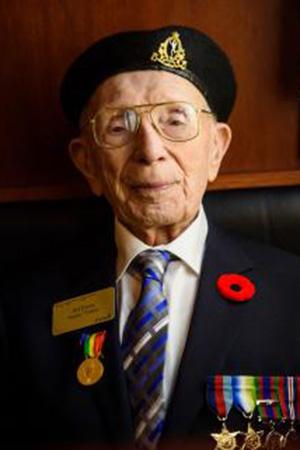
"I remembered the other men from my hometown who served during the Second World War.” Ardwell Eyres recalls of his time at the ceremonies in Halifax to mark the 75th anniversary of D Day, “There were quite a few lads from my village that enlisted. Not all of them made it back from the war.”
Eyres was born in Cameron, Ontario, and enlisted for the army on 29 April, 1943—the same day he turned 19. When asked why he decided to join, his answer is simple. “That’s what you did.”
Though a member of the army, Eyres was stationed in Halifax to serve on the troopship Ile de France as part of the Embarkation Transit Unit. “I love trains and loved watching them come right in the dock areas on the land side of Pier 21,” he says. Troops would exit one train, do a roll call before loading onto the ship. Then another train would pull up and load more soldiers. This process continued until the boat was full.
Eyres made 17 round trips across the Atlantic to transport thousands of troops, and at one point they were joined by Bing Crosby. Every trip was made without a convoy escort. “We could go fast enough to outrun German subs,” Eyres remembers, “but we had to change course every three minutes or so to help confuse the enemy.”
“We knew something big was going on.”
Of all his trips, Eyres’ first overseas trip sticks out in his memory, “I was sailing on the hospital ship, the Lady Nelson. We left Halifax at the end of May 1944. On the morning of June 6, we were in the English Channel.” The Lady Nelson was to act as a support ship for the Normandy landings. Eyres remembers that none of his fellow soldiers knew why the ship had stopped but, “We knew something big was going on because there were so many ships in the Channel.”
He earned a wartime nickname, “Laddie,” from his Regimental Sergeant Major. He had assigned Eyres to sit beside him in the dining hall for a meal. “I did ask him why he wanted me to sit with him, and he told me that he had two sons in the army and they were in Italy”, remembers Eyres. “He said, well Laddie, I hope someone is looking after my sons like I’m looking after you.”
Eyres continued to serve for a year after the war ended. The Ile de France was responsible for bringing back 10,000 troops on multiple occasions, which included wounded. “People think that when the war was over, we just all left and went back to our previous lives, but there was a lot more to do,” he says.
When he eventually discharged from the army, Eyres settled in Toronto, Ontario, married and started a family. He went to night school and eventually became an accountant. Eyres joined the Upper Canada Railway Society and would subsequently serve as club president. He became interested in recording his family history and continues to work on his family tree, recording more than 1,000 names and going as far back as 1770.
“Canadians need to remember how important that day was.”
Eyres returned to Halifax this past June to mark the 75th anniversary of D Day and the Battle of Normandy. “Canadians need to remember how important that day was” he continues, “for all the servicemen who landed on the beaches and flew over them. We had to honour the job they did.”
For his service, Eyres received the 1939 1945 Star, the Atlantic Star, the Victory Medal, and the Canadian Volunteer Service Medal and Bar.
In honour of the 75th anniversary of D-Day and the Battle of Normandy, Ardwell Eyres is one of our Faces of Freedom. He participated in commemorative ceremonies in Halifax as a member of our delegation. Discover more stories.